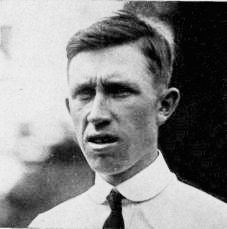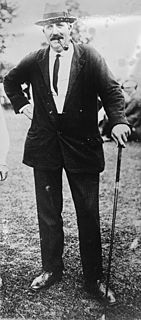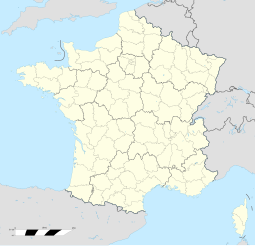
Harold Horsfall Hilton was an English amateur golfer of the late 19th and early 20th century. He won The Open Championship twice, The Amateur Championship four times, and the U.S. Amateur Championship once.

The Open de France is a European Tour golf tournament. Inaugurated in 1906 it is the oldest national open in Continental Europe and has been part of the European Tour's schedule since the tour's inception in 1972. The 100th edition of the event was held in 2016.

John J. McDermott Jr. was the first U.S.-born golfer to win the U.S. Open, in 1911 and 1912, and he remains the youngest player to win the event, at age 19, as well as the second youngest to win any of golf's four major tournaments after Young Tom Morris. He was the first player to break par over 72 holes in a significant event, which he did at the 1912 U.S. Open. He was one of the world's top players between 1910 and 1914.

Edward Rivers John "Ted" Ray was a British professional golfer, one of the leading players of the first quarter of the 20th century. He won two major championships, the Open Championship in 1912 and the U.S. Open in 1920, and contended in many others. He was captain of the British team in the inaugural Ryder Cup, in 1927.

The Belgian Open is a men's golf tournament which has been played intermittently from 1910 to 2000. All editions since 1978 have been part of the European Tour. After not having been played since 2000, it returned in 2018 as the Belgian Knockout, hosted by PietersProductions, along with its co-founder, Belgian professional golfer Thomas Pieters. With a prize pool set at €1 million, 144 professional golfers start the competition with 36 holes of stroke play, followed by 9-hole match play for the top 64 finishers from the stroke play rounds.
The British PGA Matchplay Championship was a match play golf tournament that began in 1903 and ran until 1979. Between 1903 and 1969, the event was sponsored by the now defunct British newspaper the News of the World, and was commonly known by the paper's name. Initially organised as the championship of British professionals, the event came to include invited players from other countries – in particular from around the Commonwealth. On occasion, American professionals also took part, notably in 1949 when eight members of the victorious U.S. Ryder Cup side accepted invites to the event, Lloyd Mangrum reaching the semi-finals.

The 1911 Open Championship was the 51st Open Championship, held 26–30 June at Royal St George's Golf Club in Sandwich, England. Harry Vardon won the Championship for the fifth time in a playoff over Arnaud Massy, the 1907 champion.

The 1921 Open Championship was the 56th Open Championship, held 23–25 June at the Old Course in St Andrews, Scotland. Former local Jock Hutchison won his only Open Championship, in a 36-hole playoff over amateur Roger Wethered. It was Hutchison's second and final major title.
The Irish PGA Championship is a golf tournament played annually in Ireland since 1907. It is one of the oldest golf tournaments in the world, the oldest in the country, and has been played at many different golf courses in Ireland. It is the marquee event on the PGA Tour of Ireland's schedule, having many notable winners in the over 100 years of play. Christy O'Connor Snr and Harry Bradshaw have the most wins in the event with 10. The event was played in match-play format from its inauguration in 1907 until it became a stroke play event in 1910.

Henry Abraham Mitchell was an English professional golfer. Mitchell had eight top-10 finishes out of 17 appearances in the Open Championship, his best performance being fourth in 1920. He was runner-up in the 1912 Amateur Championship and won the 1924 Miami Open.

Aubrey Basil Boomer was a professional golfer who played in the early 20th century. Boomer had three top-10 finishes in the Open Championship. He was a frequent competitor in the French Open and won the event five times.

Edward Baird Hay Blackwell was a Scottish amateur golfer who played in the late 19th and early 20th century. He was a member of the R&A and finished in second place in the 1904 Amateur Championship contested at Royal St George's Golf Club in Sandwich, England. Although playing fine golf throughout, he eventually lost the final match to Walter Travis by the score of 4 and 3. He was known as a long hitter of the ball, often outdriving opponents by 50 yards or more. In 1898, Blackwell was described as probably the most consistently long driver the world had ever seen. As a result, his name became a household word among golfers.
The England–Scotland Professional Match was an annual men's professional golf competition between teams representing England and Scotland. It was played from 1903 to the start of World War I and was then revived in 1932 and played until the start of World War II. The match was played on a single day, generally a few days before the Open Championship. Except on one occasion, there were 12 players in each team who played 12 singles matches and 6 foursomes. Scotland won the inaugural match in 1903 but didn't win another match, although three matches were tied. The event was organised by the PGA and only members of the PGA were eligible to play.
Ernest Edward Whitcombe was an English professional golfer. He was the son of Ernest Whitcombe and was always known as Eddie.
The golf competition at the Inter-Allied Games was held at La Boulie, the course of the Racing Club de Paris, Versailles, France from 2 to 12 July 1919. The event was open to all military personnel from countries that were among the Allies of World War I.
William Martin Watt was a Scottish professional golfer. He won the Scottish Professional Championship in 1912 and tied for 8th place in the 1923 Open Championship.
James Benjamin Batley (1876–1964) was an English professional golfer. His main successes came in foursomes events, winning the 1909 London Professional Foursomes Tournament and the 1914 Sphere and Tatler Foursomes Tournament. He played for England in the 1912 England–Scotland Professional Match.
James McDowall was a Scottish professional golfer. He was one of the leading Scotland-based professionals of the inter-war period, winning the Northern Open, the Dunlop-Scottish Tournament and the Scottish Professional Championship.
Michael Moran was an Irish professional golfer, the leading Irish golfer of his generation. He won the Irish Professional Championship five years in succession from 1909 to 1913 before moving to England and being ineligible to compete in 1914. He played in the Open Championship from 1909 to 1914 with a series of high finishes. He finished joint third in 1913 despite a disastrous 89 in the third round which included a 10 at the first hole. He died in France in 1918 at the age of 31.
The 1936 Walker Cup, the 9th Walker Cup Match, was played on September 2 and 3, 1936, at Pine Valley Golf Club, Pine Valley, New Jersey. The United States won by 9 matches to 0 with 3 matches halved.











